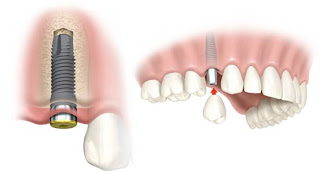A prosthodontist is a dentist who specializes in the restoration and replacement of teeth. Most prosthodontists receive two to three years of additional training after dental school in a program accredited by the American Dental Association based either at a hospital or a university. The training includes reviews of the literature, lectures, treatment of patients and laboratory experience in fabricating restorations.
¿Que es un protésico?
Un protésico es un dentista especializado en restauraciones y en remplazar dientes. Muchos protésicos reciben dos o tres años de estudios adicionales después de la escuela dental en un programa acreditado por la asociación americana dental con base en en un hospital o en una universidad. El curso incluye exámenes/críticas/revisiones de literatura, charlas / conferencias, tratamiento a pacientes y experiencia en el laboratorio fabricando restauraciones.
What dental procedures does a prosthodontist perform?
Prosthodontists are the experts in dental rehabilitation and have mastered many procedures including: crowns, caps, bridges, veneers, removable partial dentures, dentures and dental implants. In addition to restoring dental implants with restorations, many prosthodontists are surgically placing implants as well.
¿Qué procedimientos dentales lleva a cabo un protésico?
Los protésicos son expertos en rehabilitación dental y tienen dominio en muchos procedimientos incluidos: corona, esmalte, puentes, barnices, dentadura parcial removible, dentaduras e implantes dentales. Además de restaurar implantes dentales con sustituciones muchos protésicos están implantando quirúrgicamente implantes también.
Is a prosthodontist different from a “cosmetic dentist”?
The American Dental Association recognizes nine dental specialties, and the ADA does not include “cosmetic dentistry” as a specialty. Prosthodontists receive extensive training and experience in dental esthetics and cosmetics during their graduate programs which currently last three years. Many cosmetic dentists receive training during seminars or a series of courses, but this training is usually limited to weekend or possibly weeklong courses.
¿ Es diferente un protésico de un dentista cosmético?
La asociación americana dental reconoce nueve especialidades dentales, y la ADA no incluye odontología cosmética como especialidad. Los protésicos reciben una extensa capacitación y experiencia en estética dental y cosmética durante su programa para graduarse, el cual dura tres años. Muchos dentistas cosméticos reciben una formación en unos seminarios o en una serie de cursos pero estos usualmente se limitan a un fin de semana o posibles cursos semanales.
Will the prosthodontist complete all of my required treatment?
The prosthodontist is best viewed as the "architect" of your dental project. S/he has the vision of your final outcome, both the esthetics of your smile and the improved function of your bite. Often other dental specialists may participate in your treatment to help establish a solid foundation for your restorations. Every prosthodontist develops a treatment plan customized for each individual patient, and s/he will determine if adjunctive procedures by another doctor are necessary.
¿ Completara el protésico todos mis tratamientos requeridos ?
El protésico se ve mejor como el "arquitecto" del proyecto dental. Él/ ella tiene la visión de su resultado final, tanto la estética de su sonrisa y la mejora de la función de su mordida. A menudo, otros especialistas dentales pueden participar en su tratamiento para ayudar a establecer una base sólida para su restauración. El protésico desarrolla un plan de tratamiento personalizado para cada paciente individual, y él/ella determinará si procedimientos adjuntos por otro médico son necesarios.
What is a Board Certified Prosthodontist?
A Board Certified Prosthodontist has successfully completed extensive examinations by the American Board of Prosthodontics. These examinations involve written and oral examinations in prosthodontic theory and literature, the presentation of three different patient treatments, documented from the beginning to the end of the treatment and examinations over the rationale of this treatment. As a Diplomate of the American Board of Prosthodontics, the prosthodontist must successfully complete a re-certification examination every eight years.
¿ Qué es un protésico colegiado?.
El protésico colegiado ha completado con éxito extensos exámenes por el tribunal americano de protésicos. Estos exámenes incluyes exámenes orales y escritos en teoría protésica y literatura, la presentación para tres tratamientos de pacientes diferentes, propuesta desde el comienzo al final del tratamiento y exámenes sobre las razones para ese tratamiento. Como diplomado por el tribunal americano de protésicos, el protésico debe completar con éxito un examen de renovación cada ocho años.













